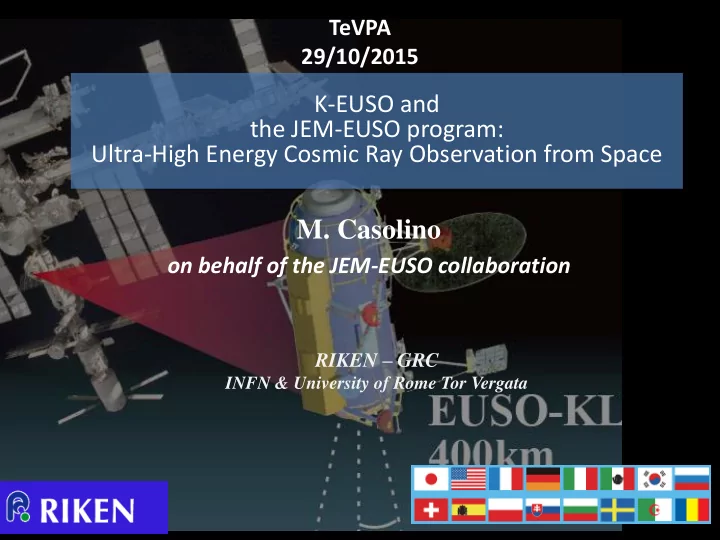

TeVPA 29/10/2015 K-EUSO and the JEM-EUSO program: Ultra-High Energy Cosmic Ray Observation from Space M. Casolino on behalf of the JEM-EUSO collaboration RIKEN – GRC INFN & University of Rome Tor Vergata
EUSO International collaboration and programmatic status • 16 countries, 200+ researchers • Evaluated positively by ESA, NASA, Roscosmoc and national agencies • Funding for detector and precursors ongoing in all countries
View from NASA: “Cosmic Ray Observatory on the ISS ” ISS-CREAM Sp-X Launch 2014 AMS Launch May 16, 2011 image from Drs. Julie A. Robinson, Program Scientist, ISS, NASA & JEM-EUSO W. Vernon Jones, CALET on JEM Launch Tentatively Senior Scientist, HTV Launch 2014 planned for 2019 SMD, NASA °
The EUSO program Ultra-High Energy cosmic rays from space 1. EUSO-TA: Ground JEM-EUSO detector installed in 2013 at Telescope Array site: currently operational 2. EUSO-BALLOON : 1st balloon flight from Timmins, MINI-EUSO CA (French Space Agency) 400 km Aug 2014; 2nd flight: 2016, NASA Ultra long duration flight: 2017 EUSO-BALLOON 40 km 3. MINI-EUSO (2017): Precursor from International Space Station (ISS: 30kg 2017). Approved by Italian EUSO-TA and Russian Space agencies 4. K-EUSO (2019 JFY): ISS Approved by Russian Space Agency EUSO-TA (2013-)
1. EUSO-TA (see Lech’s Talk)
EUSO-TA First data taking campaign in March 2015 Also used for Auger/Fast tests • Stars: 0.34 deg PSF (work also with Moon) • UV Background • Laser: Mobile, LED CLF of TA • Cosmic ray
2. EUSO-Balloon flights
EUSO-Balloon 1 st flight, Aug 2014 Timmins (CA) Payload built by JEM-EUSO collaboration CNES (French Space Agency) mission
Optics and Electronics See Takizawa’s talk
Optics and Electronics See Kawasaki’s talk
Integration in Timmins 11-24 Aug 2014
Xe flasher and Laser events from NASA helicopter
Landing and recovery Refurbished, new long duration flight in 2017
EUSO-Balloon 2nd flight, March 2017 Wanaka, New Zealand NASA Mission. 1st Super Pressure Science Flight Payload built by JEM-EUSO collaboration New lenses, Focal Surface, Electronics
3. MINI-EUSO • Approved by Italian Space Agency • Approved by Russian Space Agency • Inside the ISS • 2 Fresnel lenses and one PDM See Oscar’s talk
Scheduled for 2017 Paolo Nespoli flight on ISS
4. K-EUSO
KLYPVE+EUSO • In the Russian Federal Space Program • Passed the stage of preliminary design with Roscosmoc • Technical requirements, accomodation, operations study performed by Energia space corporation • Launch in FY 2019
Slide from TSNIIMASH-Roscosmoc, Dec 2014
General Role Sharing
K-EUSO Japan contribution (JAXA 2014 proposal)
K-EUSO exposure
Science of K-EUSO KLYPVE detector goes from technological demonstrator to instrument capable of: 1. Study of UHECR fux from space with uniform response 2. flux E>5 10 19 eV 4. Anysotropy 3. Earth observations
Additional Science objectives Measurement of Meteorites Search for Strange Quark Matter Study of Transient Luminous effects Map of night Earth in UV In m s range Bioluminescence 76
Programmatic status 1. 2013 MSU proposal of KLYPVE included in Russian space program 2. 12-2013 MSU invited JEM-EUSO collaboration to join KLIPVE 4. 2014 JAXA call mission of opportunity 5. 2-2014 Proposal Submitted 6. 8-2014 passed MDR 7. Roscosmos-NASA joint 9-2014 Signing of science protocol and role sharing between MSU and Riken, 12/2014 with int. Partners 8. 12-2014 SRR docs submitted to JAXA (>500 pages)
Conclusions K-Euso is a mission of opportunity improving with high international component a factor 10 Russian Klypve with advanced lens and PMT technology Address several fundamental physics issues Approved by Russian Space Committee Excellent precursor capable of performing for the first time UHECR physics from space
Recommend
More recommend